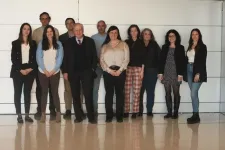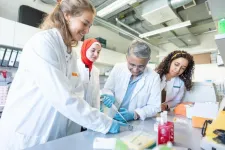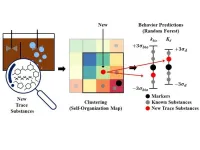(Press-News.org) Aviation has grown considerably in recent decades and accounts for approximately 2 percent of global carbon dioxide emissions and some 4 percent of all climate change impacts annually. While aviation is an important contributor to climate change and other environmental problems, electrification is one option for reducing these environmental impacts. The first electric aircraft are already in operation today and are mainly small planes used for pilot training and short flights in the immediate area. This is the type of plane that was studied in the life cycle assessment.
“In the short-term future, battery-powered electric aircraft will probably mostly be used for shorter distances, such as what in Norway is called "fjord-hopping", meaning shorter flights between deep fjords. In a larger perspective, the study shows that battery-powered electric aircraft have the potential to significantly reduce environmental impacts of aviation”, says Rickard Arvidsson, the lead author of the study from Chalmers.
The study: same aircraft, but different
The team examined a commercially available battery-electric aircraft with two seats, the “Pipistrel Alpha Electro”, in the life cycle assessment. The same aircraft is also available as a fossil fuel-powered model, enabling the researchers to make a direct comparison. The team investigated the entire impact of each aircraft from “cradle to grave” – from raw material extraction to end of life – with a functional unit of 1 hour flight time. Data and records from the aircraft manufacturer informed much of the study.
A wide range of impact categories were considered, with a focus on global warming from greenhouse gas emissions (e.g. carbon dioxide), mineral resource scarcity from the use of rare minerals (e.g. lithium for the batteries), particulate matter formation from particle emissions, acidification from acidic emissions (e.g. nitrogen oxides) and ground-level ozone formation from emissions of nitrogen oxides and hydrocarbons.
“The key take-home from this study is that small electric aircraft can have a notably lower climate impact – up to 60 percent less – and other types of environmental impacts than equivalent fossil-fuelled aircraft. However, there is a trade-off regarding mineral resource scarcity – about 50 percent more even in the most favourable scenario, mainly due to rare metals in the batteries of the electric aircraft”, says Rickard Arvidsson.
As with electric cars, the electric aircraft is comparatively worse from a climate point of view when the plane is brand new, since the production of the battery consumes a lot of energy and resources. Then, over time, the relative impact decreases as the electric plane is in use and its benefits are realised – namely, emission-free electric propulsion. The longer the electric plane is used, the better it becomes for the environment, and eventually a ‘break-even’ point is reached.
After approximately 1,000 flight hours, the electric aircraft overtakes the fossil fuel aircraft in terms of less climate impact, after which the electric aircraft is better for the environment. This is measured in kg CO2 eq/h – carbon dioxide equivalents per flight hour and is true under optimal conditions, where green energy is used. All use thereafter thus becomes a “climate benefit”, compared to the conventional aircraft. The estimated lifespan of the aircraft is at least 4,000 hours, or four times as long as the break-even time.
“The lifetime of the lithium-ion batteries, however, would have to be about twice as long for the mineral resource scarcity to be about the same for the electric airplane and the fossil-fuel aircraft. Alternatively, have double the energy storage capacity such that only one of two packs are needed onboard for the same flight time”, says Senior Researcher Anders Nordelöf, one of the other authors of the study.
New and better batteries for a greener future
In the study, the researchers discuss the further development of batteries as a major step towards reduced lifecycle impacts of the electric aircraft. Already today – but after the study was carried out – the manufacturer of the aircraft model have managed to extend the life of the batteries as much as three times. New battery technologies could further improve both climate impacts and mineral resource scarcity.
“There is a constant development of lithium-ion batteries that can improve the environmental performance of the electric aircraft and make it relatively even more preferable than the fossil-fuelled one. There are also new battery technologies that could be developed and be applicable to electric aircraft in a longer time perspective, such as lithium-sulfur batteries, although these are still in an early phase of technology development”, says Rickard Arvidsson.
More about the research:
The research is presented in the paper, "Life cycle assessment of two-seater all-electric aircraft", published in The International Journal of Life Cycle Assessment.
The researchers involved in the study are Rickard Arvidsson, Anders Nordelöf and Selma Brynolf. The researchers are active at Chalmers University of Technology in Sweden.
This work was supported by open access funding provided by Chalmers University of Technology.
About the aircraft
The electric aircraft in the study is a Pipistrel Alpha Electro manufactured in Slovenia. The wings have a span of just over 10 meters and the plane weighs 550 kg when fully loaded. Maximum flight time is about one hour, plus reserve. The battery is a 21 kWh NMC (nickel-manganese-cobalt) lithium-ion battery, and the motor produces an output of 60 kW. The Alpha Electro was a pre-series model and has been replaced by an evolved series-produced model.
The fossil fuel-based aircraft compared in the study has the same basic structure as the electric aircraft. The differences are mainly an aviation gasoline engine and fuel tank, instead of an electric motor and batteries.
For more information, please contact:
Rickard Arvidsson, Associate Professor, Department of Technology Management and Economics, Chalmers University of Technology, Sweden, rickard.arvidsson@chalmers.se , +46 31 772 21 61
Anders Nordelöf, Senior Researcher, Department of Technology Management and Economics, Chalmers University of Technology, Sweden, anders.nordelof@chalmers.se, +46 31 772 86 11
Selma Brynolf, Researcher, Department of Mechanics and Maritime Sciences, Chalmers University of Technology, Sweden, Selma.brynolf@chalmers.se, +46 31 772 22 37
The contact persons all speak English. They are available for live and pre-recorded interviews. At Chalmers, we have podcast studios and broadcast filming equipment on site and would be able to assist a request for a television, radio or podcast interview.
END
Major climate benefits with electric aircraft
2024-01-23
ELSE PRESS RELEASES FROM THIS DATE:
Multi-generational toxicant exposures show cumulative, inherited health effects
2024-01-23
While exposure to a single substance like DDT has been shown to create inherited disease susceptibility, a recent study in animals found exposure to multiple different toxicants across generations can amplify those health problems.
In the study, published in the journal Environmental Epigenetics, an initial generation of pregnant rats was exposed to a common fungicide, then their progeny to jet fuel and the following generation to DDT. When those rats were then bred out to a fifth unexposed generation, the incidence of obesity as well as kidney and prostate diseases in those animals were compounded, ...
Childhood relationships, experiences may have good and bad effects on adult heart health
2024-01-23
Research Highlights:
Positive, warm relationships between caregiver and child were associated with higher odds of attaining ideal heart health at multiple points across a 20-year span of adulthood.
Meanwhile, experiencing childhood adversity such as abuse was associated with a lower chance of reaching optimal cardiovascular health in adulthood.
Lower annual income as an adult — $35,000 or less — may confound the health effects of childhood adversity.
Embargoed until 4 a.m. CT/5 a.m. ET Tuesday, Jan. 23, 2024
DALLAS, Jan. 23, 2024 — Throughout adulthood, ...
As a carbon offset, cookstove emission credits are greatly overestimated
2024-01-23
The fastest growing type of offset on the global carbon market subsidizes the distribution of efficient cookstoves in developing countries to reduce greenhouse gas emissions, but a new study finds that the credits overestimate the stoves’ carbon savings by a factor of 10.
The overestimation undermines efforts to counteract carbon emissions to slow climate change, since companies use these offsets to meet climate targets and to sell products labeled as “carbon neutral” instead of making real reductions in greenhouse gas emissions. It also undermines ...
APOE genetic variants linked to Alzheimer disease are also associated with the development of subclinical aterosclerosis
2024-01-23
Scientists at the Centro Nacional de Investigaciones Cardiovasculares (CNIC) in Madrid have found that one of the most potent genetic risk factors for Alzheimer disease, apolipoprotein E4 (APOE4), is also associated with an increased risk of developing subclinical atherosclerosis in middle age. The study also demonstrates protection against subclinical atherosclerosis in people carrying the variant APOE2, which protects against Alzheimer disease.
The study, coordinated by Dr. Marta Cortés Canteli and CNIC General Director Dr. Valentín Fuster, sheds light on the role of APOE in the development of cardiovascular diseases ...
As easy as counting to ten – a new rule for catalysts’ design
2024-01-23
The ‘ten electron’ rule provides guidance for the design of single-atom alloy catalysts for targeted chemical reactions.
A collaborative team across four universities have discovered a very simple rule to design single-atom alloy catalysts for chemical reactions. The ‘ten electron rule’ helps scientists identify promising catalysts for their experiments very rapidly. Instead of extensive trial and error experiments of computationally demanding computer simulations, catalysts’ composition can be proposed simply looking at the periodic table.
Single-atom alloys are a class of catalysts made of two metals: a few atoms of reactive metal, ...
Supportive, stable caregiving in childhood protects heart health in adulthood
2024-01-23
Previous research has established that childhood experience with abuse, neglect, and substance use in the home can worsen a person’s heart health throughout their life. New research, however, now shows that receiving warmth from a caregiver during childhood protects cardiovascular health later in life, according to a study led by NYU Grossman School of Medicine and The Ohio State University Wexler Medical Center.
The findings, published online January 23, 2024 in the journal Circulation: Cardiovascular Quality and Outcomes, are the first to frame adversity and protective ...
Hopp Children's Cancer Center Heidelberg launches development cooperation to provide children worldwide with modern cancer diagnostics
2024-01-23
Worldwide, 40 percent of all children with cancer die from their disease*. In countries like Germany, which are among the global leaders in healthcare, 20 percent of all children with cancer do not survive their disease.
"Particularly in low-income countries, there is a lack of resources for training experts, for example specialized pathologists, and thus a lack of precise diagnostics to successfully treat children and adolescents," emphasizes Stefan Pfister, director at the Hopp Children's Cancer Center Heidelberg (KiTZ), department head ...
Ants help reveal why sourcing different plants for eco fuels is crucial for biodiversity
2024-01-23
Despite being a renewable energy source, the use of biofuel is controversial, as growing few, highly productive crops for fuel can lead to biodiversity loss in the cropping systems where biomass is produced. A cropping system refers to the crops, their sequence, and the management practices on a given field.
Now, researchers in the US have compared ant communities in different types of bioenergy cropping systems to better understand how these systems shape biotic communities and their functions. The results were published in Frontiers ...
Quickly and easily predict emerging contaminant concentrations in wastewater with artificial intelligence
2024-01-23
The global consumption of pharmaceuticals is growing rapidly every year, reaching 4 billion doses in 2020. As more and more pharmaceuticals are metabolized by the human body and enter sewage and wastewater treatment plants, the amount and types of trace substances found in them are also increasing. When these trace substances enter rivers and oceans and are used as water sources, they can have harmful effects on the environment and human health, including carcinogenesis and endocrine disruption. Therefore, technologies are needed to quickly ...
The cause of recent cold waves over East Asia and North America was in the mid-latitude ocean fronts
2024-01-23
If the world is warming, why are our winters getting colder? Indeed, East Asia and North America have experienced frequent extreme weather events since the 2000s that defy average climate change projections. Many experts have blamed Arctic warming and a weakening jet stream due to declining Arctic sea ice, but climate model experiments have not adequately demonstrated their validity. The massive power outage in Texas in February 2021 was caused by an unusual cold snap, and climate models are needed to accurately predict the risk of extreme weather events in order to prevent massive socioeconomic damage. In particular, climate technology leaders have ...







